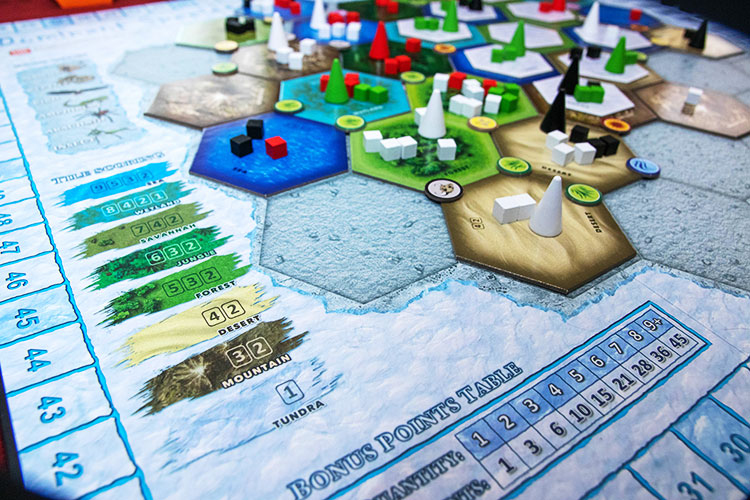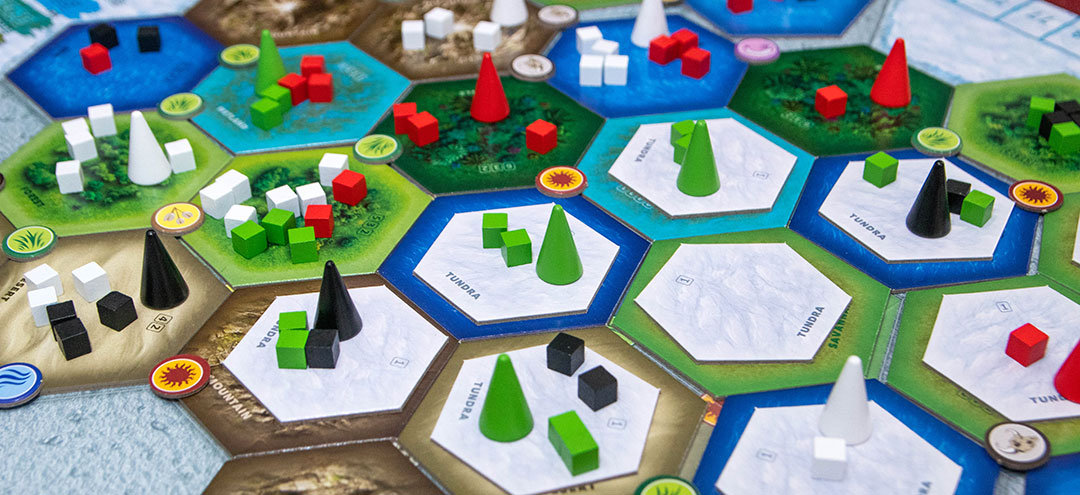 The Ice Age is coming and there is nothing we can do to stop it. Players take the role of a class of animals—mammals, reptiles, etc. and attempt to position themselves to be the strongest species once the ice starts to move in.
The Ice Age is coming and there is nothing we can do to stop it. Players take the role of a class of animals—mammals, reptiles, etc. and attempt to position themselves to be the strongest species once the ice starts to move in.
Dominant Species is a conflict-heavy worker placement game for 2-6 players. It plays best with 3 or more and play times run 2-4 hours, increasingly in length as you add additional players.
Gameplay Overview:
From the looks of it, Dominant Species is a war game. Players move cubes, representing their species, around the hexagonal map vying for control of various terrains. However, the innovation here that has gamers coming back to Dominant Species after almost a decade and 5 printings is the Euro-style worker placement mechanisms that fuel the actions in this game.

Each round players will be adapting their species, adding new elements to them to be able to live on the ever-changing globe that is slowly being turned into tundra through the coming Ice Age. In addition to the species themselves changing, the map changes as players can use their actions to add elements to the existing terrain or add new terrain to the edges of the map. Players can add new species to the board and migrate their existing species to nearby terrain.
There are, of course, options to directly attack opponents, removing their cubes slowly through the competition action. However, the main conflicts arise through the use of extremely powerful dominance cards. These action cards can have game-changing abilities—forcing your opponent’s species to regress or making them migrate off their chosen lands, for example.

The key to, well, asserting your dominance, is careful planning. All potentially random information—the dominance cards and elements available for adapting—are revealed at the beginning of the turn. You must see the writing on the wall and either beat your opponents to the actions or make sure your species become well protected from the potentially devastating effects of the cards that can be played.
Victory points are scored through the dominance action, scoring for area majority on a hex of your choice. This scoring action looks simply at the number of species (i.e., cubes) you have on the chosen hex. However, to play a dominance card as well you have to be the most dominant of all present species, meaning you must match the most elements on that hex. This leads to a delicate balance of propagating out as many species as possible and adapting into multiple elements to be able to use the dominance cards.
The player with the most species in the tundra regions also scores points each round as they are positioned to survive the Ice Age the best. The game ends when the Ice Age dominance card is played; players score again based on the number of regions they have the most dominant and most populous species and the player with the most points wins.

Game Experience:
Dominant Species is a game of tactical maneuvering and shifting priorities. As such, the theme really does come through. You see the writing on the wall—the forests are about to be overtaken by a sheet of ice. Or maybe the sea is no longer going to be hospitable for species that can only survive on terrain with grass or sun elements. You must—literally and figuratively—adapt to changing world, and enemies, around you.
There are two distinct, but vitally important things, that make Dominant Species a great game. First is the fact that all information is known at the start of the round before any players place any action pawns. There are a limited number of elements available for adapting and placing onto existing terrain each round. While this randomness can either work for or against you, it is known before you make a move. You can’t operate your species in a vacuum, it’s imperative that you watch and anticipate the actions of the other players.

Secondly, the worker placement aspect serves to both make the game easily accessible to euro gamers and serves an important role in the tactical gameplay. In initiative order, players will place an action pawn on the action they wish to take. But no actions are resolved until all pawns are placed. At that time, the actions resolve top-to-bottom, left-to-right. So not only are you reacting to the randomly drawn dominance cards and elements, but also to the actions your opponents are taking.
For instance, maybe there is a dominance card available that is just going to wreck your plans. Ideally, you’d take the first dominance spot and play that card before the others will be able to. However, if you are later in initiative maybe that isn’t an option. So you can either try to prevent that player from having dominance on any hex, making them unable to play the card, or alternatively, adapt or migrate before the card is played to limit its effects.
While the elements and hexes come out in a random order, there is little left to chance throughout Dominant Species. There are no dice to roll—if you choose the competition action to fight other species you will simply remove one of their cubes from a shared terrain tile.

The game works well all the way up to 6 players, although it can become quite a long affair you’ll have to dedicate most of your game day to. It’s worth the time investment though. And fortunately, there is rarely a runaway leader problem as players can self-balance the game by focusing their actions against those players that are happening to get out to an early lead.
It’s worth noting that the rulebook for Dominant Species has long been held up as one of the gold standards. You will have no problems learning the game from the rulebook and using it for a reference throughout your playthrough. Dominant Species is definitely a heavy game but that complexity is in the gameplay and the strategy, not in rules overhead and exception cases.
It isn’t all rainbows and sunshine with the Ice Age upon us though. First, it’s critical to know which species is dominant at all times, but that changes often throughout the round as species adapt, terrains grow abundant with new elements, and new terrain is explored on the outer edges of the map. Keeping up with the bookkeeping and moving the dominance markers around is a minor issue and it becomes second nature after a couple of plays, but can be tedious.
Final Thoughts:
Dominant Species can be a mean, frustrating game of survival of fittest. But the game mechanisms are extremely streamlined, easy to teach, and fairly intuitive to understand. Even if you don’t love direct conflict in games I think Dominant Species is worth a play at some point in your board gaming career. The combat is rarely extremely targeted and mostly just about putting yourself in the best position possible. When it is mean it’s often just to keep the front-running animals in check.
While Dominant Species has come in and out of print over the last 8 years, it’s currently widely available and is certainly worth the investment, both in time and money. It isn’t a quick game but it is a rewarding experience and one you’ll willingly come back to repeatedly.
Final Score: 4.5 Stars – Superb game design that makes survival of the fittest come to life on the tabletop.
 Hits:
Hits:
• Rewarding tactical play where you must adapt to other players’ actions.
• Worker placement action select makes it feel very much like a euro game.
• Advanced info at the start of the round allows for careful planning throughout the game.
Misses:
• Dominance upkeep can be a drag.
• With high player counts it can get a bit long and doesn’t work well at 2 players.






















